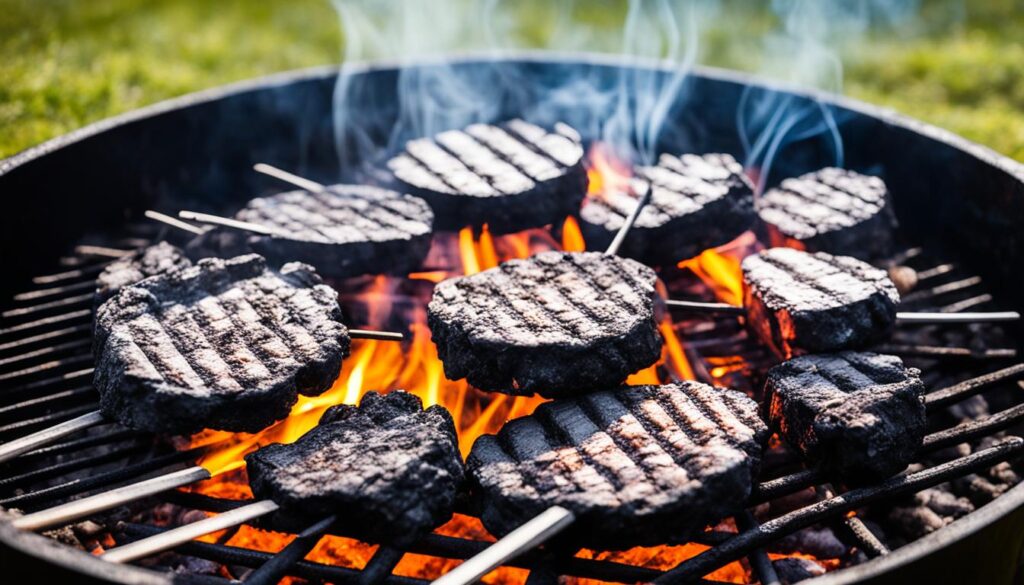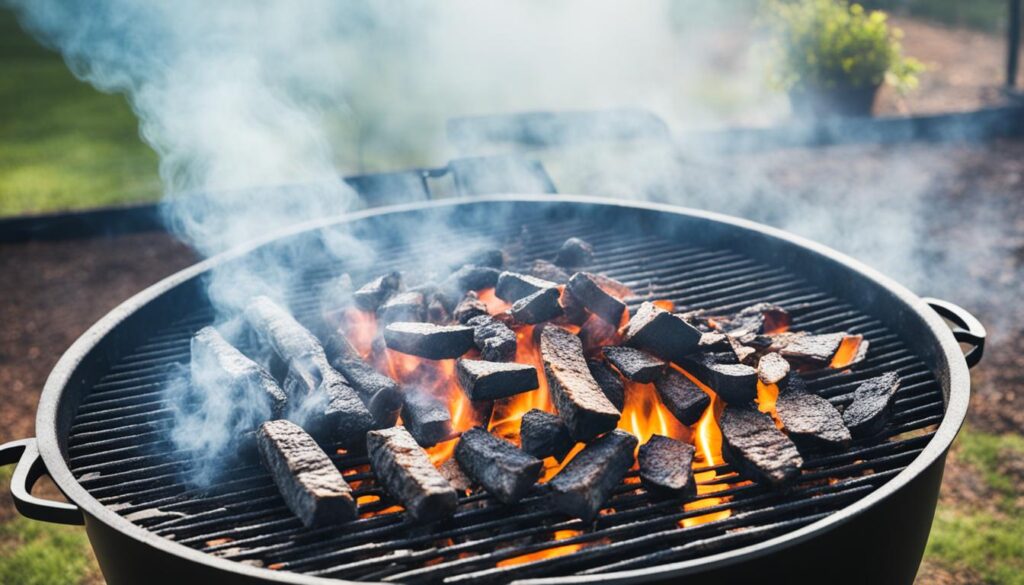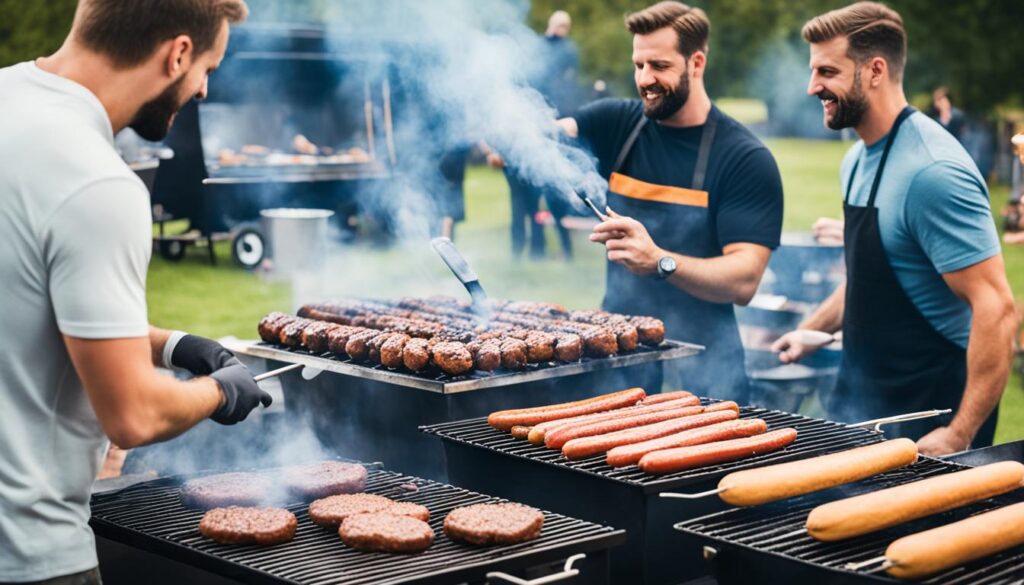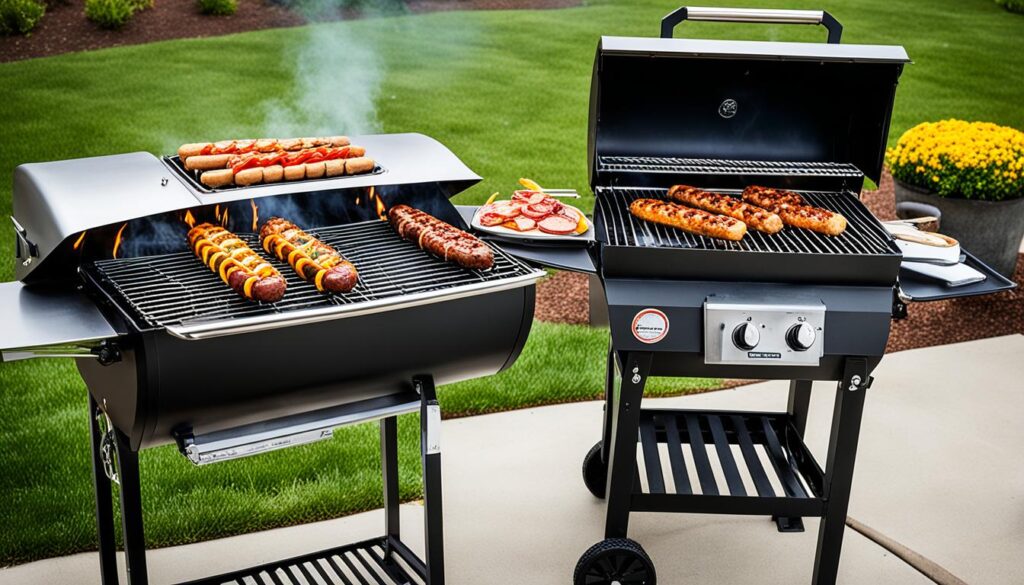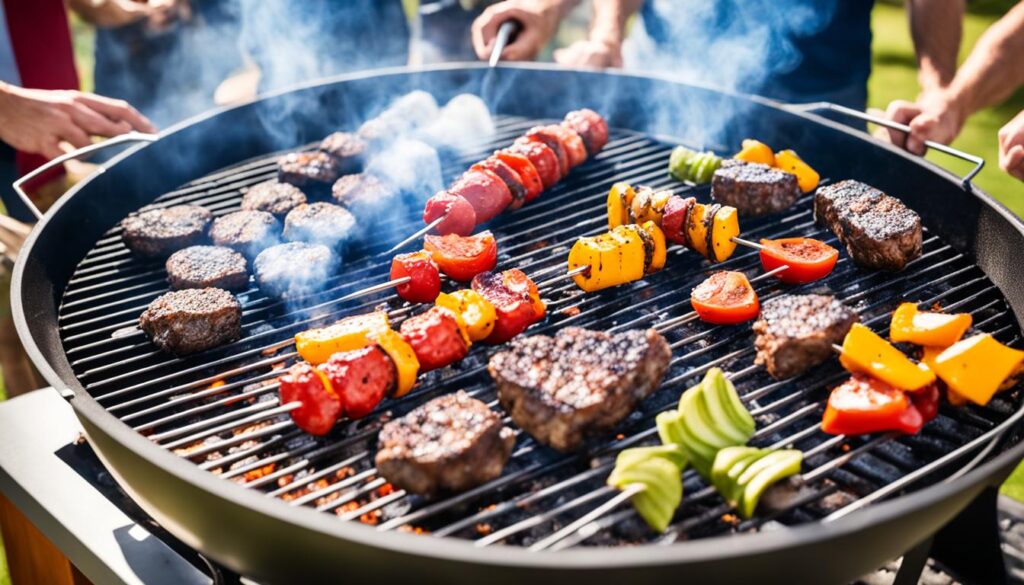Greetings, fellow grill enthusiasts! Have you ever faced the frustrating problem of your charcoal BBQ not staying lit? Fear not, for I am here to help. There can be several reasons why your charcoal BBQ is refusing to ignite or extinguishing too soon. In this article, we will explore common lighting problems, troubleshoot the issues, and provide you with effective solutions to keep your charcoal BBQ lit and your grilling game strong.
Key Takeaways:
- There are various factors that can cause a charcoal BBQ to not stay lit.
- Dry charcoal, ventilation problems, a dirty grill, improper lid usage, low-quality charcoal, improper charcoal stacking, and humid weather conditions are common culprits.
- By addressing each of these factors and implementing the appropriate solutions, you can troubleshoot your charcoal BBQ effectively.
- Starting with dry charcoal, ensuring proper ventilation, cleaning the grill regularly, using the lid correctly, opting for high-quality charcoal, stacking the charcoal properly, and considering humidity are essential steps to keep your charcoal BBQ lit.
7 Reasons Why the Charcoal Doesn’t Stay lit
There are several common reasons why charcoal doesn’t stay lit. These factors can greatly affect the ability of your charcoal BBQ to maintain a consistent flame. Let’s take a closer look at each of these causes:
- Dry Charcoal: Dry charcoal can be difficult to ignite and keep lit. If your charcoal has absorbed moisture, it may take longer to light or may not stay lit at all. It’s important to ensure that your charcoal is completely dry before using it for grilling. Leaving it in the sun for a few hours can help remove any moisture.
- Ventilation Problems: Proper airflow is essential for a strong and sustained fire. If your grill vents are blocked by ash or charcoal pieces, there won’t be enough oxygen circulating to keep the fire burning. Regularly cleaning the grill and clearing the vents can help resolve this issue.
- Dirty Grill: A build-up of ashes and grease can hinder the performance of your charcoal, preventing it from staying lit. Make sure to clean your grill before and after each use to maintain optimal airflow and ventilation.
- Improper Use of the Lid: Closing the lid too early can cause the fire to lose temperature and extinguish. It’s essential to use the lid appropriately, especially during the initial lighting phase. Keep the lid open to allow proper airflow and oxygen supply until the charcoal is well-established.
- Low-Quality Charcoal: The quality of your charcoal plays a significant role in its ability to stay lit. Lower-quality charcoal with a low carbon content may be harder to light and may produce less heat. Investing in higher-quality charcoal, such as lump charcoal made from hardwood, can result in better performance and a longer burn time.
- Improper Stacking of Charcoal: How you stack your charcoal can impact its burn time and ability to stay lit. Piling the charcoal instead of laying it flat on the grill allows for better airflow and combustion. Consider experimenting with different stacking techniques to find what works best for you.
- Humid Weather Conditions: High humidity can affect the ability of charcoal to stay lit. The excess moisture in the air can make it more challenging for the charcoal to ignite and maintain a steady flame. Storing your charcoal properly and using dry charcoal can help counteract the effects of humidity.
By addressing these factors and implementing the appropriate solutions, you can significantly improve the likelihood of your charcoal staying lit throughout your grilling sessions.
Charcoal is Dry
One of the reasons why your charcoal BBQ may not stay lit is if the charcoal is dry. Charcoal is porous and can easily pick up moisture, especially if it has been stored outside. Moist charcoal is difficult to light quickly. To solve this issue, you can dry the charcoal by leaving it in the sun for a few hours. However, it’s important to note that slightly moist charcoal can still be used for grilling, but completely dry charcoal should be used as a starter.
Ventilation Problem
Another reason why your charcoal BBQ may not stay lit is if there is a ventilation problem. Fire needs oxygen to burn, and if the vents in your grill are blocked by ash or charcoal pieces, there may not be enough airflow to sustain the fire. It’s crucial to ensure that the vents are open to allow sufficient oxygen to reach the burning charcoal. Cleaning the grill regularly can help prevent ventilation problems.
- Check the vents:
- Avoid overcrowding the grill:
- Use a chimney starter:
Make sure to inspect the vents of your charcoal BBQ regularly. Over time, ash and charcoal residue can accumulate and block the airflow. Clean the vents using a grill brush or a small wire brush to remove any debris or buildup.
Blocking the vents with excessive charcoal can hinder proper airflow. Avoid overcrowding the grill and ensure that there is enough space between the charcoal pieces to allow the air to circulate effectively.
A chimney starter is an effective tool to light charcoal and ensure proper airflow. It allows the charcoal to light evenly and quickly, promoting adequate ventilation throughout the grilling process.
By ensuring proper ventilation, you can optimize the performance of your charcoal BBQ and maintain a consistent and even fire. Remember to clean the grill regularly and pay attention to the condition of the vents to prevent blockage and improve charcoal grill airflow.
Clean Grill
A dirty grill can also hinder the ability of the charcoal to stay lit. Ashes and grease buildup can restrict airflow and prevent the fire from getting enough oxygen. It’s essential to clean your grill before and after use to remove any residue and ensure proper ventilation. Regular maintenance and cleaning will help keep your charcoal BBQ functioning optimally.
To clean your grill, start by removing the cooking grates and brushing off any food residue with a grill brush. Next, remove the ashes from the bottom of the grill using a grill ash tool or a metal scoop. Be sure to dispose of the ashes safely.
After removing the ashes, use warm soapy water and a sponge to clean the inside and outside of the grill. Pay close attention to any areas with grease buildup. Rinse thoroughly and allow the grill to dry completely before using it again.
In addition to regular cleaning, it’s important to perform grill maintenance to keep it in good working order. Check for any rust or wear and tear and address any issues promptly. Lubricate any moving parts, such as hinges and handles, with a food-safe lubricant to prevent them from sticking.
By keeping your grill clean and well-maintained, you’ll not only improve its performance but also prolong its lifespan, ensuring many successful and enjoyable grilling sessions.
Are You Closing the Lid?
If you own a charcoal grill with a lid, it’s important to understand the correct usage of the lid to optimize your grilling experience. Closing the lid too early, before the charcoal has burned evenly, can result in the fire losing temperature and ultimately extinguishing. To ensure a consistent and controlled fire, it’s best to leave the lid open during the initial stages of lighting the fire. This allows for proper airflow and an adequate supply of oxygen to the burning charcoal.
However, it’s important to note that there are specific circumstances when using the lid can be beneficial. When cooking thick steaks or large pieces of meat that require convection heat to cook evenly, it is advisable to close the lid. The lid helps retain heat and creates an oven-like environment that promotes even cooking. For regular grilling and lighting the fire, it’s best to keep the lid open to allow for effective air circulation and oxygen supply.
You Have Low-Quality Charcoal
The quality of charcoal can play a significant role in its ability to stay lit. Low-quality charcoal with a low carbon content can be difficult to light and may produce less heat. Investing in high-quality charcoal, such as lump charcoal made from hardwood, can ensure better performance and a longer burn time.
Adding fruitwoods or flavored woods to the charcoal can also enhance its flammability and add unique flavors to your grilling.


When it comes to charcoal, not all options are created equal. High-quality charcoal is the key to a successful grilling experience.
Low-quality charcoal often lacks the necessary carbon content, making it harder to light and resulting in decreased heat output.
Investing in high-quality charcoal, such as lump charcoal made from hardwood, can make a significant difference in your grilling results.
These types of charcoal have a higher carbon content, which allows for easier ignition and consistent heat production.
- High-quality charcoal provides a longer burn time, allowing you to cook your food thoroughly and evenly.
- It produces less ash, reducing the need for frequent cleaning and enhancing the overall flavor of your food.
- High-quality charcoal also tends to have larger, more consistent pieces, which facilitates better airflow and heat distribution.
When choosing charcoal for your grilling needs, be sure to look for brands that prioritize quality and have a reputation for producing high-performance charcoal.
Adding fruitwoods or flavored woods to your charcoal can elevate your grilling experience by infusing your food with unique and delicious flavors. Experiment with different wood combinations to enhance the taste of your grilled dishes.
Stack Them
When it comes to achieving a long-lasting and evenly burning charcoal fire, proper stacking is key. To ensure that your charcoal stays lit, it’s important to pile it instead of laying it flat on the grill. This allows for better airflow, ensuring that the flames are fueled adequately throughout the grilling process.
Charcoal chimneys can also be helpful in the stacking process, although they are not necessary. These cylindrical devices are designed to hold charcoal, allowing it to ignite evenly and quickly. By using a charcoal chimney, you can stack your charcoal more efficiently, optimizing the airflow and improving the overall performance of your grill.
Experimenting with different stacking techniques can also help improve your grilling success. You can try different arrangements, such as creating a pyramid or using the Minion method, where a smaller amount of lit charcoal is placed on top of a larger pile of unlit charcoal. Finding the stacking technique that works best for you and your grill can make a significant difference in the longevity and consistency of your charcoal fire.
Perhaps It’s Just Humid Outside!
Humidity can have an impact on the ability of charcoal to stay lit, especially in high humidity conditions. When the air is humid, charcoal has a tendency to absorb moisture, making it more difficult to ignite and maintain a consistent flame. Grilling in humid weather can be a challenge, but there are steps you can take to mitigate the effects of humidity and ensure a successful grilling experience.
Firstly, it’s important to store your charcoal properly to prevent it from absorbing moisture from the air. Keep your charcoal in a dry and airtight container or bag to maintain its dryness. Moisture-laden charcoal can be harder to light and may not burn as efficiently, so using dry charcoal is essential in humid conditions.


Additionally, consider using charcoal that is specifically designed for high humidity conditions. Some brands offer charcoal varieties that are labeled as “humidity-resistant” or “all-weather,” which are formulated to perform better in humid environments.
Once you’ve ensured that you’re using dry charcoal, it’s important to focus on getting the fire started and maintaining a high temperature. The heat from the burning charcoal will help to counteract the effects of humidity. Once the charcoal reaches a high temperature, the moisture absorbed from the air will have less of an impact on its ability to burn.
Top Tips for Grilling in Humid Weather:
- Store your charcoal in a dry and airtight container to prevent moisture absorption.
- Use dry charcoal that is suitable for high humidity conditions.
- Ensure proper airflow in your grill to allow for efficient burning.
- Get the fire started properly to reach a high temperature quickly.
- Maintain the grill’s temperature by adding more dry charcoal as needed.
- Consider using a chimney starter or other efficient fire starter method.
- Monitor the grill closely and make adjustments as necessary to maintain a consistent flame.
By following these tips and taking precautions against humidity, you can overcome the challenges of grilling in humid weather and achieve delicious results. Keep in mind that it may take a little more time and effort to get the fire going, but with the right techniques, you’ll be able to enjoy a successful grilling session even in high humidity conditions.
Use a Better Fire Starter Method
When it comes to getting your charcoal BBQ lit and keeping it burning, using a better fire starter method can make all the difference. By using efficient and effective tools such as charcoal fire starters, lighting charcoal becomes a breeze. One popular and reliable option is the use of chimney starters, which provide a controlled and consistent way to ignite your charcoal.
Chimney starters are designed to create a strong and even airflow, encouraging the charcoal to light evenly and quickly. Simply place the chimney starter on the grill, fill it with charcoal, and light the newspaper or firelighter at the bottom. Within minutes, your charcoal will be ready to spread out and start grilling.
Alternatively, firelighters can also be used to ignite your charcoal. These handy cubes or sticks are designed to burn for an extended period, providing a consistent source of flame to get the charcoal started. Firelighters are particularly useful in challenging weather conditions, such as windy or damp environments.
Experimenting with different fire starter methods is key to finding the one that works best for you. Whether you prefer chimney starters, firelighters, or other innovative methods, the goal is the same: to ensure that your charcoal BBQ stays lit, allowing you to enjoy that delicious smoky flavor in your grilled food.
Summary: Let’s Get That Fire Going!
In summary, troubleshooting a charcoal BBQ and fixing a charcoal grill can be achieved by addressing several common factors that prevent the charcoal from staying lit. By implementing the appropriate solutions, you can keep your charcoal BBQ lit and enjoy delicious grilled food.
- Dry Charcoal: Ensure that your charcoal is dry before lighting it. If the charcoal has absorbed moisture, leave it in the sun for a few hours to dry it out.
- Ventilation Problems: Check for blocked vents that may restrict airflow. Clear any ash or charcoal pieces obstructing the vents to allow sufficient oxygen to reach the burning charcoal.
- Dirty Grill: Regularly clean your grill to remove ashes and grease buildup. This will help maintain proper airflow and prevent any restrictions that may hinder the fire from staying lit.
- Improper Lid Usage: Use the lid correctly. Keep it open while lighting the fire to allow proper airflow and oxygen supply. Only close the lid when cooking thick steaks or large pieces of meat that require convection heat.
- Low-Quality Charcoal: Invest in high-quality charcoal with a high carbon content. Lump charcoal made from hardwood is recommended for better performance and longer burn time. Enhance the flavor and flammability of the charcoal by adding fruitwoods or flavored woods.
- Improper Stacking: Properly stack the charcoal by piling it instead of laying it flat on the grill. This allows for better airflow and ensures that the flames are fueled adequately. Consider using charcoal chimneys for easier and more efficient stacking.
- Humid Weather Conditions: When grilling in humid weather, store your charcoal properly to prevent it from absorbing moisture. Using dry charcoal and reaching a high temperature during the initial burn can minimize the impact of humidity on the charcoal’s ability to stay lit.
By following these troubleshooting steps and fixing any issues that arise, you can keep your charcoal BBQ lit, maintain a consistent flame, and enjoy successful grilling experiences. Now, let’s get that fire going!


How to Keep a Charcoal Grill Lit?
When it comes to grilling, there’s nothing more frustrating than a charcoal grill that won’t stay lit. But fear not, with a few simple tips and techniques, you can keep your charcoal grill fire burning strong for a delicious outdoor cooking experience.
First and foremost, it’s crucial to start with dry charcoal. Moisture can make it difficult for the charcoal to ignite and stay lit. Ensure that your charcoal is properly stored and protected from the elements to keep it dry.
Proper ventilation is also key to maintaining a lit charcoal grill. Make sure all vents are clear and open to allow airflow, as fire needs oxygen to burn. Regularly cleaning your grill to remove any ash or debris can help prevent ventilation problems and ensure a steady flame.
Choosing high-quality charcoal is another important factor. Opt for charcoal with a high carbon content, such as lump charcoal made from hardwood. This type of charcoal provides better performance, a longer burn time, and more consistent heat.
Additionally, consider the effects of humidity. In humid weather conditions, charcoal can absorb moisture from the air, making it harder to light and keep lit. Store your charcoal properly and use dry charcoal to minimize the impact of humidity on your grill’s fire.
Finally, using a better fire starter method can greatly enhance the lighting process. Consider using chimney starters or firelighters to ignite your charcoal more efficiently and effectively.
By implementing these tips and techniques, you can keep your charcoal grill lit and enjoy successful grilling sessions with family and friends. Happy grilling!
